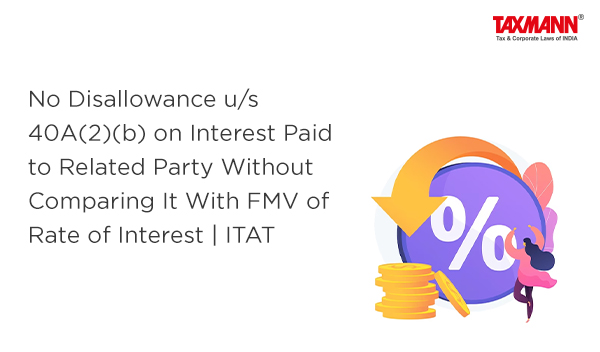No Disallowance u/s 40A(2)(b) on Interest Paid to Related Party Without Comparing It With FMV of Rate of Interest | ITAT
- Blog|News|Income Tax|
- 2 Min Read
- By Taxmann
- |
- Last Updated on 7 December, 2023

Case Details: Genxt Mobile LLP vs. ACIT - [2023] 156 taxmann.com 490 (Mumbai-Trib.)
Judiciary and Counsel Details
-
- Prashant Maharishi, Accountant Member & Sandeep Singh Karhail, Judicial Member
- Hemant Shah for the Appellant.
- Ram Krishna Kedia for the Respondent.
Facts of the Case
The assessee was a wholesale and distributor of mobile phones and accessories. During the assessment proceedings, it was observed that the assessee has paid interest at a rate ranging from 9% to 18% on the unsecured loans. It was further observed that the assessee had paid interest at 18% to a related party as per section 40A(2)(b) on an unsecured loan taken and repaid during the year.
Contending the provisions of section 40(b)(iv), which restricts allowance of payment of interest to the partner of the firm to 12% per annum, the Assessing Officer (AO) held that interest payment above 12% to related parties is squarely hit by the provisions of section 40A(2)(a). Accordingly, interest payment over 12% was disallowed, and additions were made to the assessee’s income.
On appeal, CIT(A) upheld the additions made by the AO. Aggrieved by the order, the assessee filed an appeal before the Mumbai Tribunal.
ITAT Held
The Tribunal held that as per section 40A(2)(a), if, in the opinion of the AO, the payment made by the assessee to any related person is excessive or unreasonable having regard to the fair market value of the goods, services or facilities for which the payment is made, so much of the expenditure as is considered excessive or unreasonable by the AO shall not be allowed as deduction. Therefore, the AO is required first to determine the fair market value of the goods, services or facilities for which the payment was made.
However, in the instant case, the Assessing Officer considered the interest rate as allowed under section 40(b)(vi), wherein payment of interest to any partner is allowed up to 12 per cent, as the fair market value of the rate of interest.
Thus, without finding the comparative fair market value of the rate of interest for the loan taken by the assessee, the AO proceeded to make the part disallowance.
Therefore, while partly disallowing the interest paid by the assessee, AO had not followed the provisions of section 40A(2)(a). Accordingly, there was no basis in upholding the partial disallowance of interest payment made by the assessee, and the same is directed to be deleted.
Disclaimer: The content/information published on the website is only for general information of the user and shall not be construed as legal advice. While the Taxmann has exercised reasonable efforts to ensure the veracity of information/content published, Taxmann shall be under no liability in any manner whatsoever for incorrect information, if any.

Taxmann Publications has a dedicated in-house Research & Editorial Team. This team consists of a team of Chartered Accountants, Company Secretaries, and Lawyers. This team works under the guidance and supervision of editor-in-chief Mr Rakesh Bhargava.
The Research and Editorial Team is responsible for developing reliable and accurate content for the readers. The team follows the six-sigma approach to achieve the benchmark of zero error in its publications and research platforms. The team ensures that the following publication guidelines are thoroughly followed while developing the content:
- The statutory material is obtained only from the authorized and reliable sources
- All the latest developments in the judicial and legislative fields are covered
- Prepare the analytical write-ups on current, controversial, and important issues to help the readers to understand the concept and its implications
- Every content published by Taxmann is complete, accurate and lucid
- All evidence-based statements are supported with proper reference to Section, Circular No., Notification No. or citations
- The golden rules of grammar, style and consistency are thoroughly followed
- Font and size that’s easy to read and remain consistent across all imprint and digital publications are applied



 CA | CS | CMA
CA | CS | CMA
